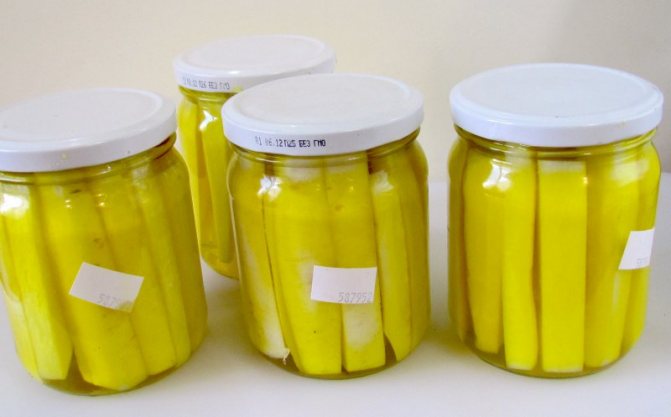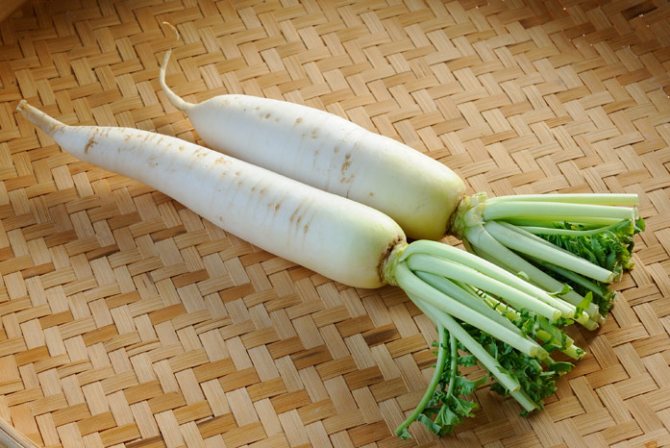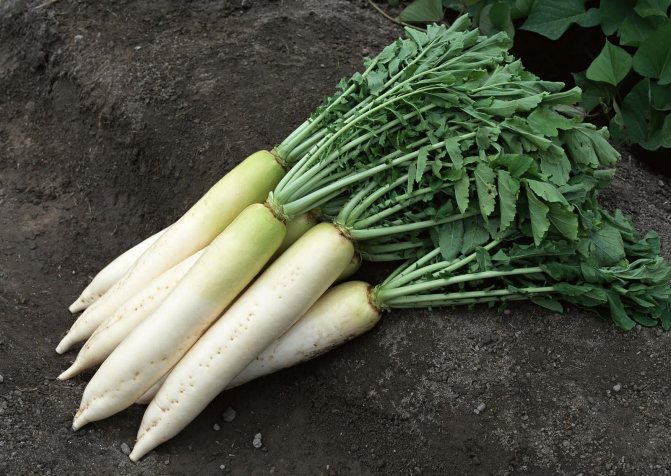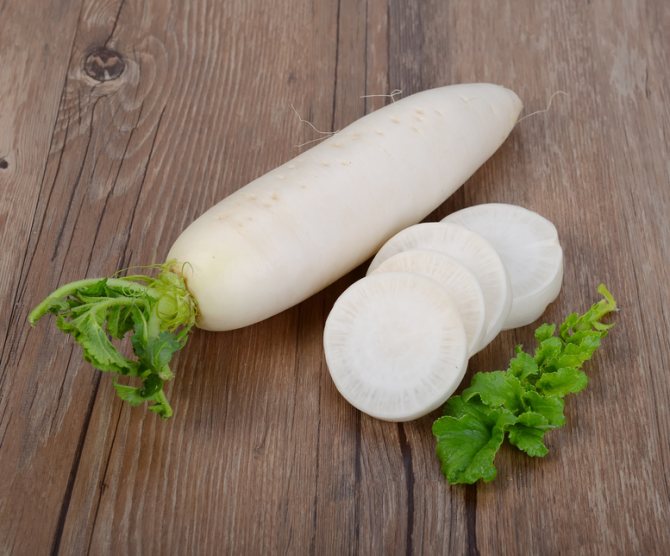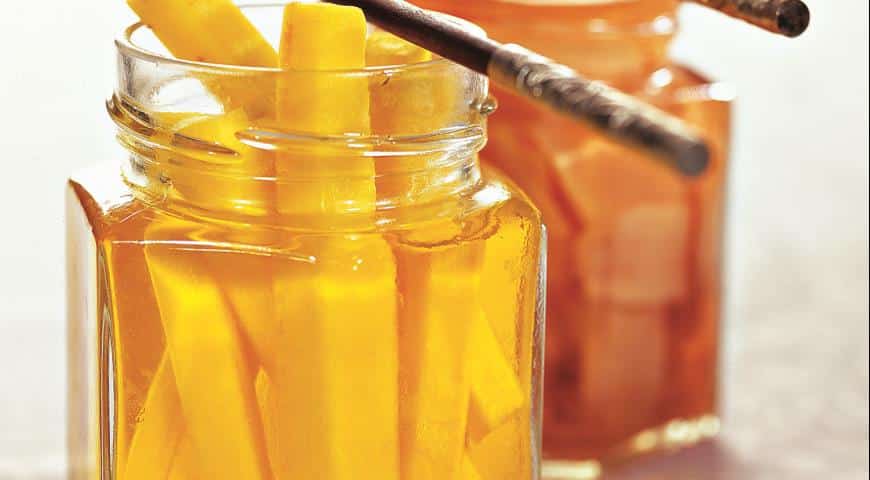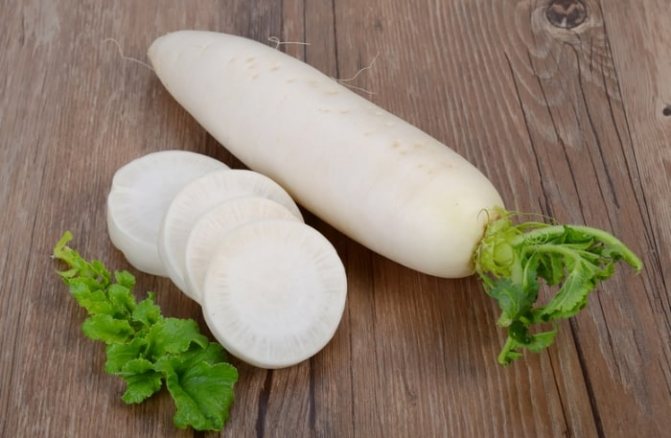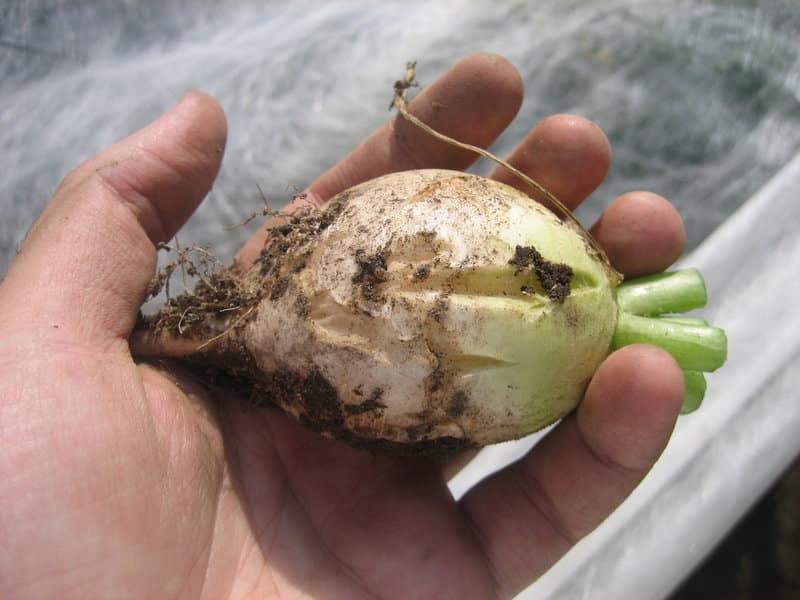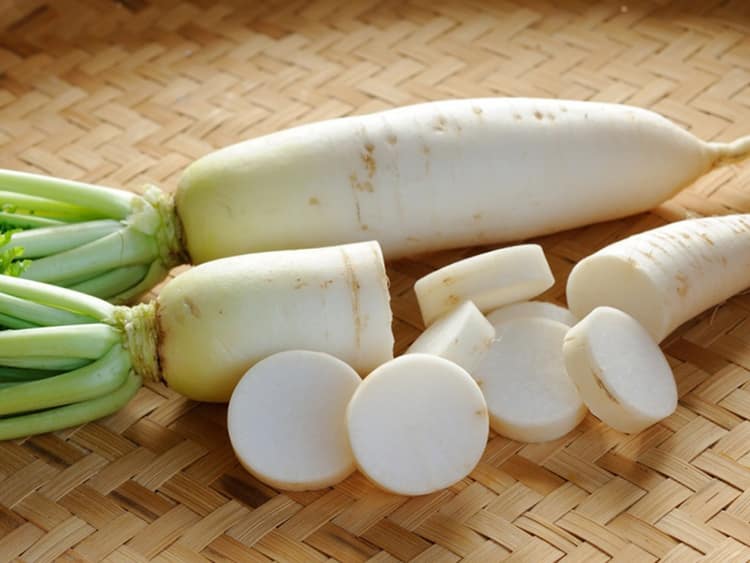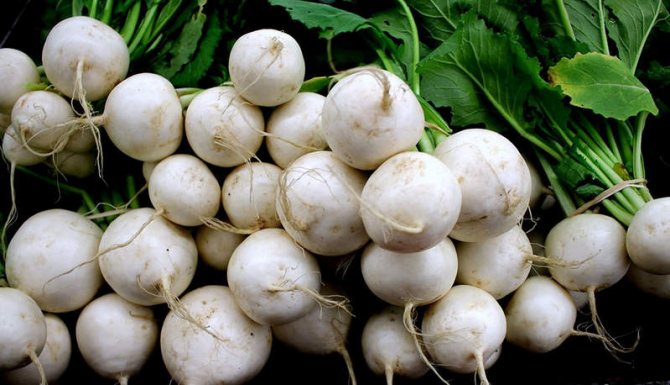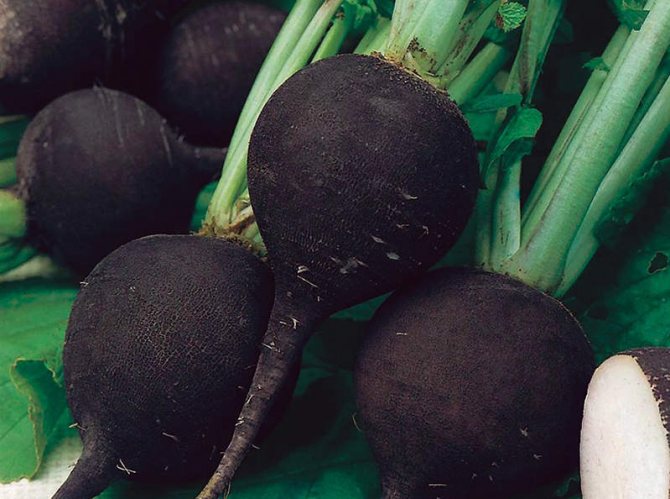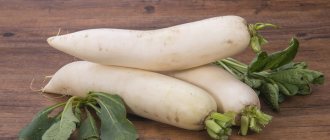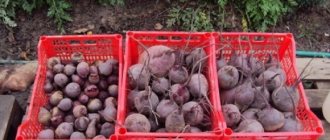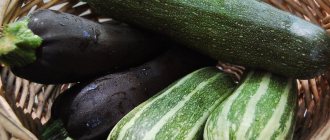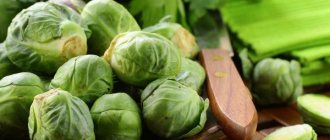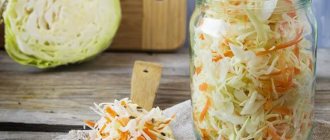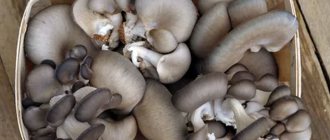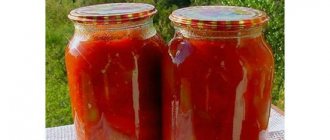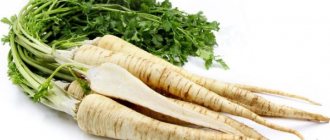When to remove the daikon? How to store daikon?
Daikon is an exotic plant, not very popular in Russian gardens. And completely in vain. This vegetable has a low calorie content, is versatile in preparation (it can be boiled, fried, stewed or eaten fresh), easy to grow, improves the functioning of the stomach and intestines, has antiseptic properties, and helps cleanse the liver and kidneys. Daikon can be used to make excellent salads that will be especially appreciated by those on a diet.
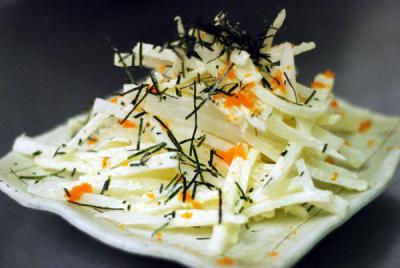
If you know how and when to harvest the daikon, then you can easily provide yourself with this healthy vegetable for the whole winter. In addition, it has a high yield.
Daikon: description
Translated from Japanese, this root vegetable is literally called "big root". It has a long cylindrical shape and looks more like a carrot than a radish, of which it is a relative. It can reach truly gigantic sizes; in our soils, you can easily grow a root crop weighing 4-5 kg. The taste is quite delicate, without pungency and bitterness, not like a radish. The daikon, the photo of which is presented below, has a rounded shape, but tastes no different from a cylindrical one and can also reach enormous sizes, the only drawback is that it is not very convenient to store it.
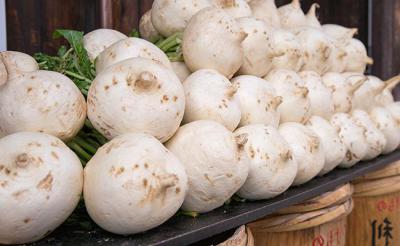

How to choose a daikon variety?
Now stores provide a very wide selection of seeds, it is best to give preference to those varieties that are bred by domestic breeders. They have the best survival rate and adaptability to our climatic conditions. All varieties can be divided into three groups depending on when to harvest the daikon. They can be early, mid-early, and late. The first group reaches maturity in 40-50 days. When to remove daikon from the garden, as a rule, it is indicated on the seed bag. For storage, of course, it is best to choose late varieties. Of the cylindrical ones, the most popular are "club", "minovashi", "fang of an elephant", "big bull". They are all mid-season. The "Sasha" variety has a spherical shape of the root crop.
How to grow daikon?
The growing period to full maturity is 60-70 days on average. Sowing seeds is best done in mid-summer, in July. The soil should be light and fertile. Remember that the vegetable is large enough and will take up a lot of space. Dig the soil deeply, add humus and superphosphate (40 g per square meter). If you do not want to subsequently thin out the garden, then it is best to immediately sow the seeds one at a time, at a distance of 10 centimeters, leave space up to 0.5 meters between the rows. This will make it more convenient to water, loosen the plants and easily recognize the time when to harvest the daikon. You can plant three seeds in one hole for safety net, then at the stage of two leaves it will be necessary to leave the largest plant, pull out the rest or transplant to another place. If the daikon is planted too early, then, most likely, it will go into the arrow and bloom. This is due to the fact that this plant has a short daylight hours, therefore it is advisable to plant a daikon in the second half of summer.
Step-by-step instructions: how to assemble?
Dry cool days are considered favorable. Frost and hot sunny weather are harmful for the root crop. If frost hits the vegetable, then decay processes will begin quite quickly during storage. And in the heat, it withers and also becomes unsuitable for storage.
Inventory
The use of the inventory depends on the quality of the soil. If the ground is dense, heavy, then you will need a shovel or a pitchfork with blunt ends. For loose sandy soil, you can do without them.
Process
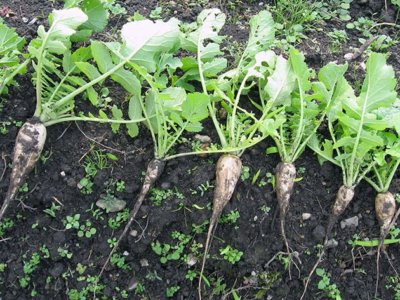

The collection process is not complicated at all. But root vegetables can go deep enough into the ground, and they are very brittle. Therefore, you need to harvest very carefully. If the soil is loose, then just pull the tops and remove the vegetable from the ground. And for heavy ground you will need a pitchfork or a shovel. Try to dig carefully so as not to damage the root crop. The root of the plant can go into the ground to a depth of 50-60 cm.
If you cannot extract the radish, then you should dig it around and, swinging it, carefully remove it so that the vegetable can be easily pulled out of the ground. Separate the plants you want to seed. Better to use the summer harvest. Then, in the fall, a new seed will be ready.
Cut the tops, leaving the stalks about 10 cm long. Keep the root vegetables in the refrigerator for about ten days. Re-plant in the ground at an angle so that the daikon grows until the seeds are fully ripe.
Storage preparation
Cleaning is best done in dry weather. After digging up, leave the Japanese radish on the garden bed in the shade for a while, so that the earth on it dries up and crumbles. Daikon skin is delicate and can be damaged very easily. Therefore, do not wash off the soil from the root crop with water and do not brush it off.
You can only gently shake off with your hands or a soft cloth. The damaged vegetable will not be stored for a long time. Try to prevent the sun's rays from falling on the root crop, from which it becomes flabby. We cut off the tops, but leave small stalks of about 2-3 cm. During storage, they will be a kind of indicator of freshness. If the petioles are green and not wilted, then everything is in order with the root crop.
Diseases and pests
The very first and main enemy is the cruciferous flea, it damages the leaves very badly. To scare away, use ash, which is sprinkled on wet soil in the garden. To prevent its appearance, many gardeners recommend planting daikon along with onions. This can be done in a checkerboard pattern. In May, you need to plant onions at a distance of 20 cm from each other. And after 1-1.5 months, plant daikon seeds. By this time, onion greens will noticeably grow, the smell of which surprisingly scares off the pest. You can also use hot red pepper infusion for watering.
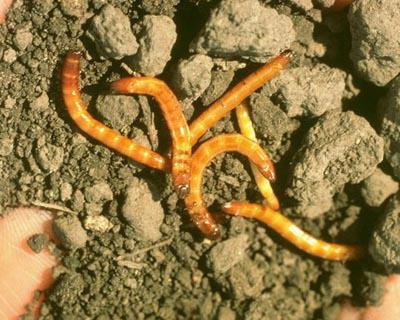

Another daikon lover is wireworms. They significantly damage the flesh of the root vegetable, making numerous holes, such vegetables will be practically unsuitable for storage. It is very difficult to get rid of the wireworm, since, as a rule, all the soil on the site is infected.
The wireworm is the larva of the click beetle. To destroy it, it is necessary to plant legumes and mustard after the main crop from the site has been harvested. The introduction of coniferous needles into the soil in spring helps. Late autumn plowing of the garden is also effective, when frosts have already begun. This contributes to the destruction of the larvae.
How to prepare a white radish?
- If the root crop is grown on a personal plot, it is important to harvest on time. You need to dig up vegetables for long-term storage in mid-September, in dry weather. The root crop should dry out in a dry, ventilated place. 2-3 days outdoors in sunny cool weather is sufficient.
- After drying, the vegetables need to be sorted out, leaving only strong, smooth fruits. A vegetable with damage, irregular shape, discoloration is set aside for food immediately after harvest.
- The next step is to clean the surface from dirt. The radish cannot be washed with water.The fruit is cleaned with a soft cloth from excess soil or a special brush with a soft bristle. Do not damage the skin.
Daikon radish: when to clean?
Harvesting is carried out, depending on the variety, after 40-70 days. Late-ripening varieties should be harvested after cold, dry weather, but before frost. If the temperature drops below zero, then the root crops will certainly be damaged, at least the ground, protruding part. In the future, this will prevent long-term storage. Therefore, it is important for each variety to know its time - when to harvest the daikon. If the soil is heavy, then it is impossible to pull out by the tops, too long root will break. In this case, you need to carefully dig with a shovel or pitchfork.
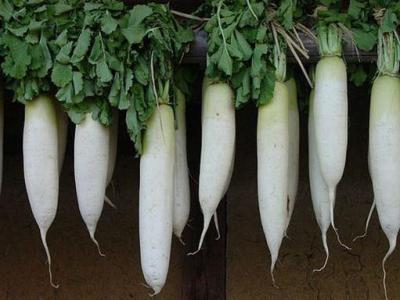

After that, the daikon must be allowed to lie down in the air so that the earth that remains on it dries up and crumbles. But do not expose the vegetable in direct sunlight, it may begin to flabby.
Read also: How to eat celery, what parts of the plant are considered edible and healthy
Cleaning time
In early ripening varieties of Japanese radish, root crops are formed after 30-35 days, in mid-ripening varieties - after 60-70 days, and late-ripening varieties - after 90-120 days. 15-20 days before harvesting the radish, you can feed with ammonium sulphate, which contributes to the formation of a rounded lower part in root crops, improving the quality of the peel, depending on the early maturity of the variety.
A list of factors that determine the timing of cleaning:
- features of the planted variety;
- the time of planting in the soil;
- soil condition;
- weather;
- growing region.
For the Moscow region, the Central strip and other regions
The timing of harvesting depends on the region and the time of planting. Distinguish between summer and winter daikon, but these names are arbitrary, because the first is planted in the spring and harvested in the summer, and the second at the end of summer and harvesting is done in the fall.
Advice
The harvest that is harvested in the fall is usually more than that harvested in the summer.
Daikon is a short day culture that requires a lot of water, which is abundant in early autumn.
| Region | Seed sowing dates | Harvesting |
| Moscow region and middle latitudes |
|
|
| Krasnodar region |
|
|
| Ural and Siberia | End of July. | September October. |
| Sakhalin and the Far East | End of July - beginning of August. | September October. |
How to store daikon?
For the best preservation, you need to choose the best root crops, without damage, floors, cracks, even and smooth. Therefore, it is important to know how and when to remove the daikon from the garden. Carefully cut the tops off with scissors. Prepare coarse river sand, sift it. Large wooden crates will be required. Lay the Daikon in even rows and sprinkle each layer with plenty of sand. Store boxes in the basement at a temperature not lower than zero, but not higher than 5 degrees Celsius, and low humidity. If the vegetable is too large and cannot be used in one go, then you can put it in a bag and store it on the bottom shelf of the refrigerator. If you know how to store the daikon correctly, observe the thermal regime and humidity, then the root crop will lie for at least three months.
Fundamental rules
The main conditions for the long-term preservation of the vegetable:


The optimum air temperature in the storage room is from 0 to + 5 C. The maximum allowable temperature is up to + 10 C. The humidity should be from 95 to 98%. The vegetable should not dry out and be exposed to excessive moisture. There should be no fluctuations in temperature and humidity.
Summer and winter daikon
There are no mustard oils in daikon. It has no side effects on the human body. It is capable of exerting the following effects on the human body:


helps to fight cancer;- cleanses the body;
- stabilizes the nervous system;
- cleanses the intestines;
- normalizes the formation of bile, etc.
Daikon looks like a large white carrot. Therefore, it has a second name "big root". It is useful in any form ─ salted, fresh and boiled. Daikon is a low-calorie dietary vegetable. It contains a large amount of various trace elements, vitamins, pectin substances.
The nutritional properties of daikon accelerate the process of removing harmful substances from the body, as well as strengthen the immune system and cleanse the kidneys and liver of toxins.
The vegetable belongs to cold-resistant plants, therefore, it is bad to treat the heat and long daylight hours. For sowing some daikon varieties, spring is suitable. The harvested crop is consumed in the summer diet.
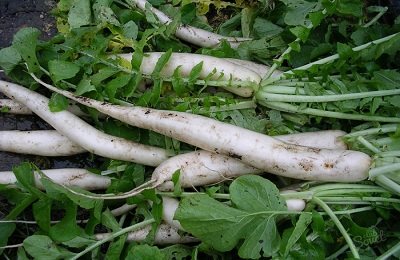

Gardeners are beginning to think about how to store the daikon in order to preserve all the nutrients in it. Most winter varieties are intended for summer sowing. Sowing begins in the second half of July and continues until the first days of August. This is the most favorable period for daikon growth. Daylight hours decrease and temperature decreases. To preserve the root crop when the temperature drops to + 10˚, gardeners are advised to use Lutrasil or Spunbond. Under this material, the root crop continues to grow well. Harvested in the fall.
When to remove the daikon? Gardeners use the generally accepted scheme. After the first shoots have appeared, you need to count 70 days to harvest. Overexposing it in the ground is not worth it, as flower stalks can form, which will lead to a loss of nutrients from the vegetable. To collect the seeds, the daikon with arrows is dug up, and after 2-3 days they are planted back in the ground. This is the only way to get quality seeds.
Shooting is not formed in summer daikon varieties. Summer varieties are not suitable for long-term storage, but are intended for quick use.
Summer residents know that the harvesting of the daikon is influenced not by the characteristics of the variety, but by the weather conditions. When to remove the daikon and how to store it, the gardener decides individually, because much depends on the soil and conditions of care, pest control, etc.


The vegetable is very susceptible to the first autumn frosts. They can harm the part of the root crop protruding from the ground. This leads to decay of root crops during winter storage. To prevent this from happening, it is recommended to start harvesting in September as the root crop grows. Many people think that it is better to dig a daikon in the first half of October and always in dry and sunny weather. It can be easily removed from loose soil. It is enough to pull on the tops. If the ground is heavy, you will need a pitchfork or shovel.
How can you tell if a culture is ripe?


To determine when to harvest, you can follow the day counting scheme. After planting, 40-70 days should pass before harvesting. It depends on the variety of the white radish and the weather conditions. By the time of harvesting, the roots protrude 2/3 of the soil and are very easily pulled out.
It is not worth keeping them in the ground longer, because flower stalks begin to form, which leads to the loss of nutrients. If you follow the growing rules and adhere to the recommended planting dates, then the collection period will be at the end of October.
How to store daikon?
Before sending the crop to storage, it is carefully examined, damaged roots are removed. Only strong, juicy, healthy vegetables should be sent to the designated storage areas. Suitable for storing daikon:
- Refrigerator. Summer varieties of plants are stored in the refrigerator for 20-30 days. They need to be well rinsed from the ground, placed in a plastic bag with holes and try to quickly use them in your diet. Since over time it loses its taste ─ it becomes soft, rot or mold appears.


Basement.Only winter varieties of a large root are subject to long-term storage. How to store the daikon depends on the preferences of the hostess and the storage space. After digging, it must be dried in the sun for 4-5 hours so that the earth dries out and crumbles on the vegetable.
It is not recommended to wash off the soil from the root crop with water, but rather to cut off the tops. Then put it in a dry storage room for 2 days, and only then put it in boxes and put it in a cool place. In the basement, you can overlay the boxes with sand or moss, periodically moistening them.
If the humidity in the cellar is 70-90%, and the temperature is from + 1˚ to 5˚C, then the daikon can be stored until spring. All nutrients will be preserved in it. When storing radish with carrots and beets, summer residents observe good results. To do this, you need river sand, which is poured over layers of vegetables.
Read also: Fundazol: instructions for use, reviews, analogues, substitutes
- Plastic bag. After drying the vegetable and removing the tops, it is tightly packed in plastic bags. Loosely tied packages are placed on the shelves in a cool room, at a temperature from 0 to + 7˚С. The shelf life under such conditions can last up to 5 months.
- Freezer The root vegetable, washed and cut into pieces or grated on a food processor, is placed in a plastic bag with holes and frozen in small portions. Defrost at room temperature. With a single freeze, all the nutrients and appearance of the vegetable are preserved.
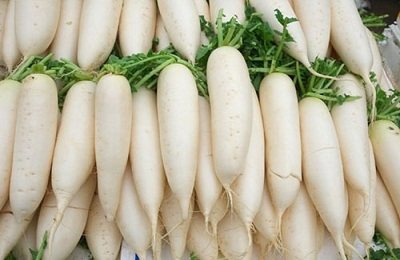

Balcony. To store the daikon on the balcony in winter, it is recommended to build a box and upholster it with felt or insulation, which is used in construction. Thus, the required temperature will be maintained in it and severe frosts will not spoil our harvest.- Barn or summer room. After primary processing, the roots are placed in a canvas bag. Bags are placed in prepared wooden boxes, and they are insulated with a blanket on top.
- daikon - 500 g;
- apple cider vinegar - 150 ml;
- water - 200 ml;
- granulated sugar - 3 tbsp. l;
- salt - 1 tsp;
- seasonings - 2 tsp.
If there is no storage space for whole vegetables, you can recycle it. In this case, a juicer will come to your aid.
With the correct cooking technology, all nutrients and trace elements are preserved in it. To do this, pour the squeezed juice into sterilized glass jars and stand in a water bath for 20-25 minutes. Then roll up with tin lids and put in a cool dark place.
Daikon canning
The canned vegetable has a pungent and bright taste. In winter, this salad is a great addition to the dinner table.
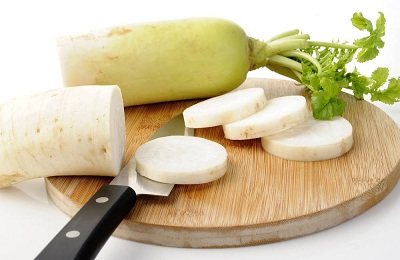

To preserve daikon, you need the following ingredients:
- Sterilize half-liter jars.
- Rinse and peel the vegetable.
- Cut into cubes 10-12 cm long.
- Place the sticks vertically in the jars.
- Preparing the marinade:
- boil water;
- add salt, sugar, vinegar and bring to a boil;
- add spices.
- Pour the marinade over the radish jars.
- Roll up with tin lids and leave to cool completely.
- Put away in the cold.
Daikon can also be canned as an ingredient in salads, for example, Winter salad is very popular. To prepare it, you will need the following ingredients:
- daikon - 1.8 kg;
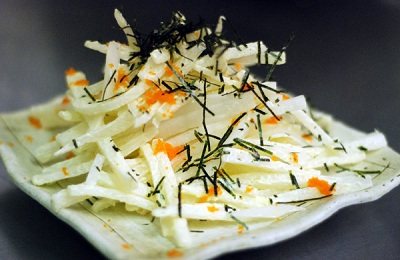

onions - 450 g;- carrots - 800 g;
- garlic - 150 g;
- vegetable oil - 150 g;
- rock salt - 1.5 tbsp. l;
- granulated sugar - 2 tbsp. l;
- apple cider vinegar - 80 ml.
- Grate the peeled vegetables on a Korean grater.
- Cut the onion into half rings.
- Mix vegetables and add garlic, pressed through a press.
- Add the rest of the components.
- Stir vegetables and leave for 40-50 minutes.
- Divide into banks.
- Sterilize for 15-20 minutes.
- Roll up and leave to cool.
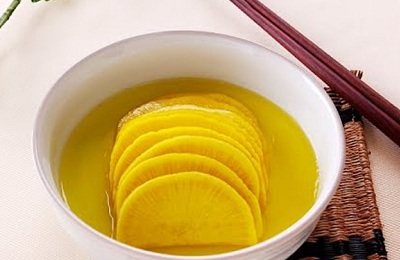

The Japanese vegetable must be preserved for the winter. Gentle canning methods preserve all nutrients in full.In winter, they are very necessary for the body. When to remove the daikon so that it retains elements such as iron, potassium, calcium, phosphorus, sulfur and copper? Experienced gardeners consider the end of September and the beginning of October to be the best period for harvesting daikon. But the exact time depends on weather conditions, daikon varieties, soil and growing conditions.
Now the daikon, the benefits and harms of which have already been fully studied and appreciated, occupies vast territories of plantations, both in Japan and in other states.
In Russia, this vegetable has become a fairly popular plant crop. It is consumed fresh, boiled, steamed and stewed and they try to save this vegetable for use in winter. It is quite possible to preserve the daikon throughout the winter if all storage conditions for this vegetable are observed.
Note to the hostess - recipes and dishes from daikon
- Daikon salad. Daikon 0.5 kg, 1-2 carrots and an apple, 3 tablespoons mayonnaise. Thoroughly wash the daikon, carrots and apples, peel, grate, salt, season with mayonnaise, mix. Garnish with herbs before serving.
- Daikon with mayonnaise... Daikon 250 g, mayonnaise 60 g, salt to taste. Wash the root vegetable, peel and grind it on a coarse grater, season with mayonnaise, salt, mix, decorate with herbs.
- Daikon salad with walnuts. Doikon 0.5 kg, carrots 2 pcs., Walnuts (12 pieces, 1/2 lemon for juice and zest, 6-8 cloves of garlic, salt. Wash, peel and finely grate root vegetables of daikon and carrots. in a mortar with garlic, pour in lemon juice, salt to taste, add lemon zest and mix.
- Daikon with oil. Daikon 250 g, vegetable oil 20 g, 1/2 tablespoon of 3% vinegar, herbs and salt to taste. Rinse and peel the root vegetable, grind on a grater, season with vegetable oil, salt and mix. Add some vinegar if desired. Put in a salad bowl, sprinkle with parsley or dill.
If you have a desire to grow radish in your garden, you need to congratulate - this is a very wise decision! It remains only to find out a few questions, the main one of which will be when to plant the radish.
Why is it so important? It's very simple, if you plant the radish at the right time, you will grow a good harvest that you can use until spring. It must be said that people have long developed a respectful attitude to this vegetable; it was present on the table of our ancestors - the Slavs - almost every day. With minimal care, the unpretentious radish gave a bountiful harvest, it was consumed fresh, boiled, stewed.
In ancient Greece, there was a custom to bring a radish as a gift to the gods on a golden platter, since the god Apollo, the patron saint of medicine, had the opinion that this vegetable should be valued for all the gold. The Arab healer Avicenna considered radish to be the main medicine. And they were right, radish contains many substances valuable for the body.
When you need to harvest daikon radish from the garden for storage for the winter
In winter, vitamins, fiber and other beneficial trace elements are available in fresh fruits from the garden, provided that the harvest is correctly collected and then placed. In order for the roots to remain strong and juicy for many months, it is important to know when the daikon radish is removed from the garden for storage.
The vegetable has a small amount of calories, it is consumed fresh or added during cooking to dishes.
Japanese radish has the following positive qualities:
- improving the activity of the gastrointestinal tract;
- antiseptic properties;
- help in cleansing the liver and kidneys.
Errors
You need to store the crop correctly. The most common errors are:
- storage of early maturing varieties;
- non-observance of the temperature regime and the permissible level of humidity;
- the presence of fungus and parasites in storage areas;
- improper neighborhood with other vegetables;
- the presence of rodents;
- non-compliance with sanitary standards;
- rare check for rot, damage.


In order to avoid mistakes and damage to the crop, it is important to store only late varieties or winter varieties. Early maturing varieties are never stored in winter. They are suitable for direct consumption.
Any place to store the daikon should be:
- clean;
- dry;
- free of mold and mildew;
- with the required level of humidity, temperature and lighting.
Periodically, you need to sort out the fruits, for the timely detection of spoilage, rot, mold.
Daikon is a delicious, healthy vegetable. It is suitable for fresh consumption and in the form of blanks, juice. Japanese radish is available all year round, with proper storage and adherence to the recommendations for preparing the vegetable and place for preservation.
If you find an error, please select a piece of text and press Ctrl + Enter.
Collecting daikon for storage
The crop is harvested when cool and dry weather sets in, but frosts have not yet come, because sub-zero temperatures damage the ground part of root crops and you will have to forget about long-term storage. You should not overexpose them in the ground, otherwise voids will form inside, and the pulp will lose its taste and become tough.
If the radish has grown on heavy soil, you cannot pull the tops during harvesting, because of this, the root system breaks easily.
It is recommended to scoop up vegetables with a shovel or pitchfork.
After the daikon is completely removed from the beds, it is necessary to put the fruits in the air to dry the earth remaining on them. In order not to damage the thin skin, it is not recommended to wash and clean the harvested vegetables; it is only permissible to shake off the remaining soil from them slightly. It is necessary to protect the radish from the sun's rays, as it becomes flabby from them.
Read also: Tomato "Nastenka" - a description of the variety, photos and reviews of those who planted
General storage tips and tricks
In order for the vegetable to be stored longer in winter, it must be properly removed from the garden and prepared for storage, adhering to the following recommendations:
- collection of fruits must be carried out on a fine dry day;
- you need to dig out the root crop carefully so as not to damage it;
- after the vegetable is removed from the ground, it is laid out on the garden bed so that it dries up;
- whole radish is selected for maturation, without damage;
- before sending the vegetable for storage, it is necessary to cut the tops 1.5-2 cm from the top of the root crop.
How to store a radish?
The best storage option is drawers with holes. They allow you to accommodate a large enough number of root crops and arrange them so that they do not touch each other. The holes made in the container allow air to circulate freely, which has a positive effect on the safety of the product.
Before laying vegetables, it is necessary to inspect again for defects and sort out the damaged ones. Then the selected specimens should be laid out in boxes and sprinkled with sand.
Where to store it?
One of the suitable places for long-term storage of radish is the cellar, but if the appropriate conditions are created in it:
- no mold and pests;
- humidity no more than 85%;
- the temperature is kept at the level of + 2 ... + 4 ° С.
In a cellar or basement, under appropriate conditions, the product can retain its useful qualities for up to 9 months.
You can store this vegetable on the balcony or in the refrigerator. But in these places, the storage time will be significantly shorter.
(No ratings yet)
Storing daikon
Before placing vegetables for the winter, the entire radish harvest is moved and inspected. Fruits left for long-term storage should be even, smooth, not damaged. The tops are carefully cut with scissors.
How to store daikon correctly? There are several ways to do this.
Placing radish in basements and cellars is one of the best solutions. After all, it is there that the optimal conditions for vegetables are created. Root crops, which are harvested in the last days of September - early October, are preserved for the longest time.
Before harvesting, wooden boxes are purchased or made independently, then they are engaged in sifting coarse river sand.
Vegetables are carefully inspected before long-term storage. Root crops with damaged skins and signs of decay are immediately sifted out. A small spot on the surface of a different shade is a clear indication of the beginning of product deterioration. Such a radish will not be able to hold out even for 1 month, but it will easily destroy the crop, as it is a source of bacteria.
Daikon is laid in even layers and covered with abundantly wet sand. It is important that the roots only touch the sand, not each other. The boxes are stored at a temperature of + 1 ... + 5 degrees. Humidity should be around 70–90%.
Ideal conditions for storing daikon are a stable temperature regime, no sunlight, maintaining moisture in the boxes (periodic moistening of the sand will help to achieve this).
Dry sand is able to draw moisture out of the radish, thereby damaging the crop.
The Japanese daikon in cellars is perfectly preserved next to carrots and fodder beets.
In a refrigerator
Many gardeners grow daikon in small quantities. They have several root crops in the composition of the crop, which can be saved at home in the kitchen. Each radish is wrapped in an air-permeable bag. You can make holes on it with a fork. All vegetables are stacked on the bottom shelf in the refrigerator. This way of storing the daikon, you can achieve the freshness of vegetables for three to five weeks.
Attention! Before placing the radish in the refrigerator, do not wet it, much less wash it. After all, this will quickly ruin the harvest. Root crops can be dried and lightly cleaned of soil residues. Of course, fruits with damaged skins are eaten immediately, they cannot be stored for a long time.
Daikon keeps well until next summer in the freezer. For this, root crops are cut or ground on a coarse grater. If it is small, then the radish will secrete juice, and as a result, a frozen ice lump will turn out, which will then be problematic to eat.
Pre-crushed daikon is placed in small portions in plastic bags or special plastic containers. All this is placed in the freezer.
When the radish is needed, it is taken out and thawed at room temperature before use.
Important! This method allows the preservation of beneficial trace elements in the fruit. If the thawed daikon is removed to the freezer again, then such a vitamin-rich product will become a tasteless sluggish mass devoid of any benefit.
Conservation
Daikon can be used to make snacks and put them in jars for the winter. Usually a salad is made from fresh root vegetables and carrots. Ingredients in the form of vegetables and seafood are added to it.
The gas station is selected independently to choose from:
- vegetable oil;
- mayonnaise;
- oil-lemon.
The preparation of a snack begins with grinding the daikon, it can be rubbed on a coarse grater or cut into cubes. The radish is mixed with carrots, then everything is poured with marinade and hermetically tightened with a lid. Banks are kept in cool places.
For the marinade, you will need the following ingredients:
The resulting mixture is brought to a boil, then cooled. These pickled vegetables serve as the basis for winter salads, as an independent dish, or are added to meat.
A harder marinade can be prepared for the daikon. First, apple cider vinegar and rice vinegar are mixed, then lemon zest, turmeric, garlic and a hot seasoning of your choice are added. The fruits are cut into rings or half rings. This appetizer will be to the taste of the household and will surprise the guests.
cooking method
Wash the Daikon thoroughly and remove the top layer with a thin sharp knife. Cut across the grain into thin slices. Cut hot peppers into small pieces. Cut the zest of one lemon into thin strips. Mix vinegar with water, sugar and salt.
Put the daikon in a sterilized jar, sprinkle with pieces of pepper and lemon zest. Pour marinade over and seal tightly. The daikon prepared in this way can be consumed within a day. And you can store it in the refrigerator throughout the winter.

